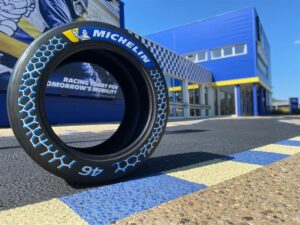Michelin MotoE tires average 40 percent sustainable materials with help from Enviro
Paris, France – Last year, Michelin announced the introduction of sustainable materials in MotoE™ tires, to the tune of 33% at the front and 40% at the rear. This year, the Michelin development teams have overcome a new challenge by integrating no less than 46% sustainable material in the rear tires, thus allowing for reaching an average rate of 40%, corresponding to the weighted average of the mass of the front and rear tires. This result is clearly in line with the Group’s ambition to reach an average of 40% sustainable materials across all its ranges by 2030. “Although ambitious, this objective remains no less realistic for Michelin. The MotoE™ tires are a new illustration of this.” said Cyrille Roget, Director of technical and scientific communications for the Michelin Group. And he added: “it is mainly in integrating more natural rubber and recycled carbon black in the tires that we have been able to make progress.” Notably, Michelin has joined forces with Enviro to develop and widely industrialize an innovative pyrolysis technology that allows for recuperating certain original components, such as carbon black. The carbon black recycled in this way is reintegrated into the manufacture of new tires.
Another principle dear to Michelin: the tire’s environmental footprint. Michelin believes that a tire comprising 100% sustainable materials would still not be a “sustainable tire” if the integration of these materials were to lead to a deterioration in the environmental impact compared to current solutions, whether in terms of design, production, transport, use or recycling. The Group therefore takes eco-design principles into consideration at every stage in the tire’s life cycle. “This is an equation that is far from simple, the solution for which requires great innovative power, just like that of Michelin. This is also what sets us apart.” said C. Roget.
As laudable as it is to want to integrate bio-sourced or regenerated materials into the tire, you must also be capable of moving from the prototype to mass production, while reproducing the same level of quality and performance. A hurdle that is often difficult to overcome, but which is decisive for the future of a new product. This challenge was also conquered for the MotoE™, tires, since today, approximately 1500 tires are manufactured and used throughout the season. “With the MotoE™ tires, we are also proving that we are capable of doing what we say. At Michelin, respecting facts is a core part of our values. This is what makes us stand out, and gives us another good reason to believe that we will overcome the challenge of 100% sustainable tires by 2050.” adds C. Roget

